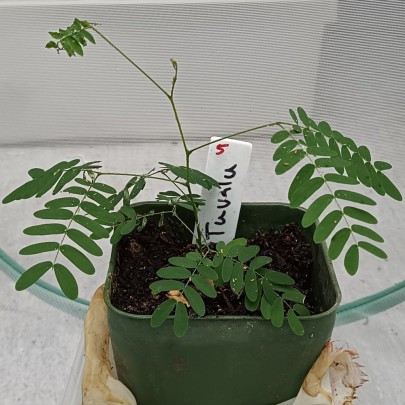Leucaena and the Leucaena psyllid
In this section
-
Pacific weeds and natural enemies
- African tulip tree
- Hibiscus Bur and the Hibscus Bur lace bug
- Leucaena and the Leucaena psyllid
- African tulip mite
- Meet the Pacific weeds
- Meet the Pacific natural enemies
- African tulip beetle
- Air potato (Hoi)
- Air potato beetle
- Hibiscus bur
- Hibiscus bur lace bug
- Leucaena
- Leucaena psyllid
- Chromolaena
- Chromolaena gall fly
Leucaena is a small tree, commonly growing to 3-15 m in height but can reach up to 20 m in height. It is a fast growing, short lived (20-40 years), nitrogen fixing plant that does well in a wide range of environments. Leucaena produces vast numbers of hard coated seeds which remain viable for at least 10-20 years. These seeds allow the plant to spread rapidly and colonise new area. Leucaena can be used for timber, firewood, shade, fodder and erosion control, but intensive management is required to prevent it from becoming invasive.
Impacts
Leucaena can quickly outcompete and replace other vegetation, disrupting natural successional processes. Coastal areas, semi-natural areas, roadsides, waste ground, plantations, hedgerows, recreational areas and agricultural land are all at risk. Biodiversity is reduced and ecological processes such as nutrient cycling and soil chemistry are affected. Leucaena can be toxic to animals and can reduce growth in pigs. Its recommended that leucaena should not make up more than 10% of the diet of pigs. Leucaena’s ability to rapidly colonise newly disturbed areas makes it particularly well-suited to take advantage of changing environmental conditions, including those caused by climate change. Therefore, the impacts of leucaena are expected to increase in the future if the plant cannot be better managed.
Control Methods
Leucaena has a large root mass that can resprout vigorously if the plant is cut off at ground level. Additional treatments are required to ensure plant death include herbicide after felling or using a cutter bar operating at 30cm below ground level to cut through the root system. This makes control expensive and labour intensive, and environmental impacts of using herbicides needs to be managed. However, a natural enemy is available which offers new hope. A leaf sucking psyllid (Heteropsylla cubana) can be highly damaging to susceptible varieties of leucaena and will not attack other plants. This natural enemy can be used to reduce the invasiveness of leucaena.
Leucaena Psyllid Heteropsylla cubana - a natural enemy of leucaena
This leaf-feeding psyllid is native to tropical America but has become established throughout much of the Pacific following the spread of its host plant leucaena (Leucaena leucocephala). By 1984 the psyllid had reached Hawai’i and from there it rapidly colonised other Pacific Islands. Leucaena is used in agroforestry but has also become an invasive weed in many countries. Due to leucaena’s commercial value, the psyllid is also considered a pest and some varieties of leucaena have been bred specifically for resistance to it. In 2024 the psyllid was released on Funafuti in Tuvalu to control leucaena, or tamalini as it is known there.
How would I recognise a psyllid and what is its lifecycle?
The psyllids develop through five wingless immature stages (instars) before becoming winged adults. The early instar larvae are pale yellow while older larvae develop black markings on the abdomen and head. The juvenile life stages are collectively known as nymphs. The adults are tiny (1-2 mm long) so can be hard to see. They will jump or fly off when provoked.
Plants infested with psyllids look like breadcrumbs have been sprinkled on the leaves. This is due to a mixture of all the life stages, white skins shed during moulting, and honeydew droplets produced by the psyllids during feeding.
The eggs take around 2-5 days to hatch and the nymph stage lasts around 8 days. Females live for about a fortnight after reaching adulthood, with males a few days less. Each female can produce 300-500 eggs. The eggs will be hard to see as they are so small (0.3 mm long). But if you have a magnifying glass you may see small yellowish-white dots on the upper leaf surfaces and in unfurled leaves. Usually, 4-5 eggs are laid per leaflet but up to 16 eggs per leaflet can occur when population numbers are high.
How does it damage leucaena?
Both nymphs and adults feed on and damage the soft new growing tips. They insert their needle-like mouthparts into the leaf tissue and suck out the fluids which causes leaf shrivelling and defoliation. Nymphs initially feed together in the area where they hatch, later dispersing as they age.
How effective is it?

Growing tip killed by psyllid attack.
In a laboratory study the psyllids quickly destroyed the growing tips of small potted plants grown from seed sent from Tuvalu. Their impact post release in Tuvalu will be monitored.
In other countries with susceptible leucaena the psyllids can rapidly kill seedlings. Repeated attacks lead to defoliation and occasionally the death of large plants. Flowering may also be prevented. The impact of the psyllid can be particularly severe when conditions are dry.
How can I get the most out of they psyliids?
Given how readily the psyllids have dispersed to many places to date, it is likely that they will spread to other islands in Tuvalu. However, if this does not happen quickly and redistribution proves necessary, the psyllids could be shifted by collecting leaves infested with nymphs and tying them to the new growing tips of leucaena plants at new locations.
Are there other natural enemies for this weed?
The natural enemies of leucaena in its native range have not been well-studied. A seed-feeding beetle (Acanthoscelides macrophthalmus) was released in South Africa but does not damage enough seeds to have a useful impact. A moth (possibly Labdia sp.) commonly destroys many seeds inside leucaena pods in the Pacific, but not enough to provide sufficient control.



